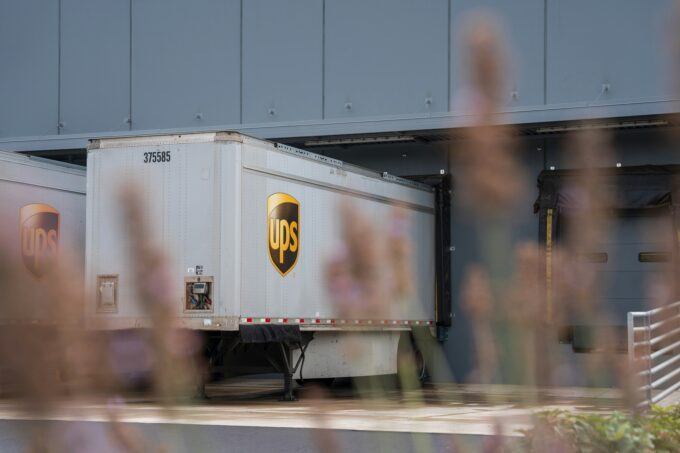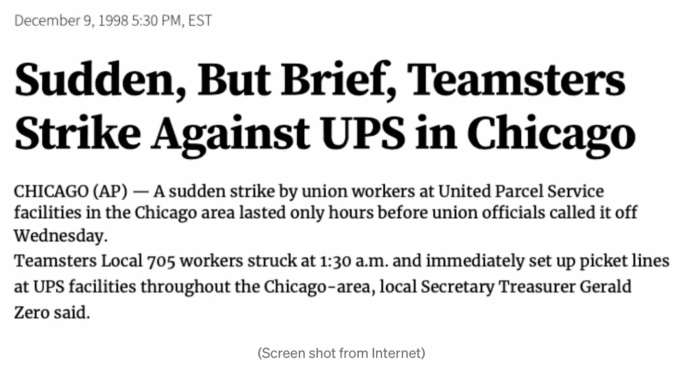
Image by Salvador Rios.
Like many people, I woke up early last Tuesday morning to find an excited post in my Facebook news feed from the Teamsters: “At 11th Hour, UPS Bows to Teamsters Strike Threat in 7 States.” It boasted that the union has flexed its muscles and that UPS capitulated:
United Parcel Service (UPS) bowed to a credible, coordinated strike threat authorized by the International Brotherhood of Teamsters around midnight after the union demanded the multibillion-dollar corporation cease multiple attacks on workers’ rights.
With picket lines ready to assemble in the early morning hours Tuesday across seven states, the Teamsters secured a handful of settlements from UPS on outstanding grievances as well as a first contract for newly organized workers. At the direction of General President Sean M. O’Brien, Teamsters were prepared to strike UPS at its largest air hub, Worldport, in Louisville, Ky., and across the Chicago area, and to extend picket lines to California, Massachusetts, Pennsylvania, Georgia, and Ohio if UPS did not retreat.
While the Teamsters appear to have walked away from the “strike threat” with a couple of things in hand: grievances settled and a first contract. But, moving the company to implement air conditioning in delivery vehicles and creating full time jobs appears to be as elusive as ever.
The Teamsters freely admitted in their post that:
Under Article 18 of the Teamsters contract, UPS is obligated to deliver at least 28,000 vehicles equipped with air conditioning. The upgraded language marked a significant win for delivery workers, who face extreme heat conditions for months on-end to ensure the company remains successful. Halfway into the agreement, UPS is woefully behind, having rolled out far less than 10 percent of the required new fleet.
“The enforcement of our national contract must now only heat up. We need all members ready to punch back at a moment’s notice,” O’Brien said. “The Teamsters demand that UPS make good now on delivering thousands of additional vehicles with air conditioning to our local unions in Zone 1, the hottest working environments for delivery drivers in the nation. UPS is fully and finally out of time to do right by our members. No more excuses, no more delays.
“No more excuses, no more delays” could be demanded of Teamsters’ General President Sean O’Brien. There have been several opportunities to strike UPS over the last three years but the union has balked every time, despite the bloviating rhetoric from the top leaders of the union.
Many Teamster rank and filers seemed baffled by the proclamation of victory over UPS in social media posts across the internet. Even on the official Teamsters Facebook page comments many UPS Teamsters were openly critical, if not contemptuous, for example:
“Sounds like none of the striking members knew there was a strike or a threat of one and it’s already settled
seems like some smoke and mirrors by the union to me.”
“Teamster bosses blowing smoke and lighting fires… but forgot to tell their members? So organized.”
“When were sleeper teams going to be informed about this so they didn’t inadvertently cross a picket line. Kinda wild that there was a strike being set up and nobody knew about it until it was resolved.”
“Only 43 states to go?!”
“World port was ready to strike??? That’s news to me lol”
While others expressed the hope that this was the first step in fighting the company, the record at UPS, up until now, is of the O’Brien leadership using social media as a substitute for collective strike action. Other who should know better, like the Teamsters for a Democratic Union (TDU), the former rebel rank and file group, now allies of O’Brien, rushed to his defense:
“The right to strike over deadlocked grievances is a powerful tool. But it has never been used until Sean O’Brien pulled the trigger this week. When UPS deadlocked a series of grievances, the IBT issued 72-hour strike notices in Denver, Toledo, and Louisville.
Members from the affected locals were dispatched to California, Pennsylvania, and other states to prepare to extend picket lines. Extensions were targeted at key chokepoints in the UPS network like the air hub in Ontario, Calif. Within hours, UPS management settled the previously deadlocked grievances on safety, seniority, and subcontracting in the union’s favor.”
But, no trigger was pulled.
Real vs. Threatening

I know something about grievance strikes. On December 9, 1998, Teamsters Local 705 under the leadership of Jerry Zero called a grievance strike at UPS. The company had deadlocked on over four hundred and fifty grievances over supervisors doing union work. Transport Topics, the major freight industry newspaper at that time, reported:
“Teamsters Local 705 workers struck at 1:30 a.m. and immediately set up picket lines at UPS facilities throughout the Chicago-area, local Secretary Treasurer Gerald Zero said.
Strikers were called off the picket lines at 9 a.m. after talks were scheduled with management for later Wednesday on job assignments and overtime, local spokesman Paul Waterhouse said.
Mr. Zero said the union was upset with what it says is the continuing practice of UPS supervisors performing work that should go to union workers, robbing them of overtime opportunities. He said UPS supervisors average about 20 to 25 minutes of such work per shift, and he expected it to worsen over the busy holiday season.”
I have to say it was also a lot of fun, but it illustrates the difference between a real grievance strike and a fake one.
UPS also tried to use the opportunity to sow divisions in the membership. Shortly afterwards, during the following Christmas holiday, 705 Teamsters received a letter from then UPS Chicago District Manager Noel Massie condemning our strike as illegal and irresponsible. At Chicago’s Jeff St. Hub, where I worked, several of us handed out a response to Massie, in a semi-regular newsletter we called the “Brown Boxer,” after Christmas.
We wrote:
“Why strike? While UPS seems totally bewildered by why our union called a strike against them. The real issue is why they didn’t see it coming — the issues have been laid out clearly before them for the last six months. The union has 450 grievances over supervisors doing bargaining unit work that UPS agreed to comply with but continues to violate every day. Ultimately, our grievances have to be backed up by real muscle or UPS eventually tear-up our whole contract.”
Sound familiar?
The 1998 grievance strike by Teamsters 705 also took place in political context UPS announcing that it would not honor the full time jobs provisions of the contract won the year before in the historic strike, and the federal government’s witch hunt of the Teamsters’ General President Ron Carey, the only reformer ever elected to the leadership of the union. UPS was clearly testing Teamsters 705’s resolve and got punched in the face. Few other local unions, if any, followed 705’s lead.
The political context today is that Sean O’Brien is running for reelection, while UPS is carrying out a major offensive, closing over seventy buildings, laying off twenty thousand workers, refusing to create the jobs required by the contract and air conditioning package cars. The union appears to be a weak bystander to all of this, and O’Brien resorts to his methods of posturing and videos to make up for real collective action. At the same time, O’Brien deepens his alliance with the Trump administration as it eviscerates workers’ rights and trade unions.
Meanwhile, the suffocating heat and humidity continues to pose a serious health hazard for UPS’s vast workforce of package car drivers and hub workers across the country. Texas UPS driver Hayden Koenig made a heartfelt plea for help recently in the Texas Observer:
“There’s a good chance you heard about me on the news last year. I’m the UPS driver who almost died when I fainted at the wheel from heat exhaustion and crashed my truck into a tree.
I still work at UPS as a proud member of Teamsters Local 767. But if the company doesn’t keep its promise to give me A/C, there’s no telling if I’ll make it through another Texas summer.
When I think back to my accident, I can’t believe how lucky I was. That crash easily could’ve killed me or other innocent drivers and passengers. But who’s to say how long luck is going to win out? How many more lives does UPS need to endanger before they finally get their act together and deliver the protections we need from the heat?
For the sake of every UPS Teamster and anyone else on the road, let’s hope the answer to that question is zero. Rest assured, if UPS management keeps dragging its feet on A/C delivery, over 340,000 UPS Teamsters are ready to do whatever it takes to finally make it a reality.”
By a funny coincidence, I was being interviewed on the Rick Smith Show last Monday night before the non-strike happened. When I was asked if the Teamsters should strike UPS, I argued that the back-and-forth on striking or not had a corrosive effect on the members confidence in the union, and it was time to decide what kind of strike to hit UPS with. After all, workers’ lives are at stake.
The post The Teamsters’ Non-Strike at UPS appeared first on CounterPunch.org.
From CounterPunch.org via this RSS feed


